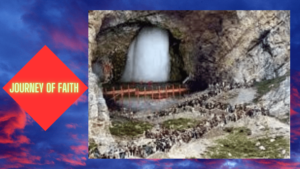In the picturesque landscapes of Kashmir, the baba amarnath darshan, a holy pilgrimage of immense significance, has encountered some hurdles this year. Amidst reports of dwindling numbers of pilgrims and the gradual melting of the snow-covered Shiva Lingam inside the Gufa Mandir, authorities in Kashmir have temporarily suspended the amarnath yatra darshan, citing “urgent repairs.” While officially ongoing, the pilgrimage is facing challenges due to reduced pilgrim flow and the need for immediate repairs and maintenance along sensitive stretches of the route, especially towards the revered Gufa Mandir.
Scheduled and organized by the Amarnath Shrine Board, this year’s pilgrimage was intended to become the longest journey in history, with hopes of over five lakh pilgrims visiting the sacred Gufa Mandir situated high in the mountains of South Kashmir. The aim was to showcase the fragile Himalayan environment, a hotspot of climate change, and demonstrate “normalcy” in Kashmir after the revocation of Article 370 by the central government.

In preparation for the pilgrimage, the authorities had made elaborate arrangements, deploying dozens of security personnel for the safety of each pilgrim, as they journeyed from Jammu to the Gufa Mandir in South Kashmir. Due to security concerns, local residents in Kashmir faced significant inconveniences as civilian vehicles were restricted from roads when the pilgrim convoys advanced towards the Gufa Mandir.
This year, to enhance security and monitoring, six base hospitals were established along both routes to the Gufa Mandir. Thousands of security personnel, drones, helicopters, and RFID tags were utilized to ensure the safety and tracking of pilgrims. The lieutenant governor of Jammu and Kashmir, Manoj Sinha, asserted that “more pilgrims will provide more livelihood opportunities to local people and contribute to the economic development of Jammu and Kashmir.”
Although initially attended by large numbers of Hindu devotees, the count has been decreasing. By August, only 984 pilgrims chose to embark on the pilgrimage via the Chandanwari and Baltal routes from the Jammu base camp. This reduction was further observed on Monday, August 21st, with only 362 pilgrims taking the baba barfani yatra, all of them opting for the shorter Chandanwari route. This route is situated at an altitude of 3,888 meters and is considered the longest among the twin routes leading to the Gufa Mandir.
Authorities emphasized the urgent need to fix the steps leading up to the temple and the path leading there. However, despite the favorable weather this year, there was no clear clarification about the repairs required in the pathways taken by the pilgrims.

According to reports, over 4.4 lacks of pilgrims have offered prayers at the temple during this year’s journey, which is a tremendous number. Unfortunately, due to natural reasons or accidents, 43 pilgrims lost their lives during the pilgrimage. This emphasizes the requirement for ongoing efforts to enhance safety conditions.
While in previous years, the Amarnath Yatra was shortened due to the abrogation of Article 370, it was revived after a three-year hiatus. There are challenges and debates surrounding the trip. A report titled ‘amarnath yatra: A Militarized Pilgrimage,’ prepared by the Jammu Kashmir Coalition of Civil Societies in 2017 addressed issues of militarization, communal conflicts, resource exploitation, and ecological degradation stemming from the pilgrimage.
In conclusion, this year’s amarnath yatra, a religious pilgrimage, has had its share of difficulties. But devotees’ continued spiritual journey and to protect the Himalayas’ delicate ecosystem, authorities continue to work toward greater management and safety.
